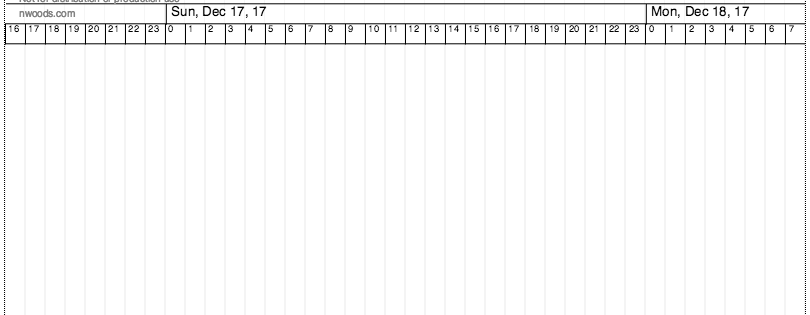Hi @walter, i am using the code from Rulered Diagram : Diagram with Rulers
My code for creating the timeline is as follows:
myDiagram =
$(go.Diagram, "myDialogBox", // create a Diagram for the DIV HTML element
{
initialContentAlignment: go.Spot.Center, // center the content
"undoManager.isEnabled": false, // enable undo & redo
scrollMode: go.Diagram.InfiniteScroll, // allow the diagram to be scrolled beyond content
padding: 0, // scales should be allowed right up against the edges of the viewport
"grid.visible": false,
_widthFactor: 1, // a scale for the nodes' positions and widths
allowHorizontalScroll: true,
allowVerticalScroll: false
});
myDiagram.grid =
$(go.Panel, "Grid",
{
name: "GRID",
visible: false,
gridCellSize: new go.Size(20, 70),
gridOrigin: new go.Point(0, 0)
},
$(go.Shape, "LineV", { stroke: "lightgray", strokeWidth: 0.5, interval: 1 })//,
);
myDiagram.grid.visible = true; // so that this example shows the standard grid
myDiagram.div.style.background = "white";
// Keep references to the scales and indicators to easily update them
var gradScaleHoriz1 =
$(go.Node, "Graduated",
{
graduatedTickUnit: 20, pickable: false, layerName: "Foreground",
graduatedMin: 0, graduatedMax: 3600, // 3600 = minutes in 2.5 days
isInDocumentBounds: false, isAnimated: false
},
$(go.Shape, { geometryString: "M0 0 H3600" }),
$(go.Shape, { name: "DateVLine", geometryString: "M0 0 V20", interval: 24 }),
$(go.Shape, { geometryString: "M0 0 V20", interval: 1, strokeWidth: 3, stroke: "white" }),
$(go.TextBlock,
{
font: "10pt sans-serif", interval: 24, graduatedEnd: .99,
alignmentFocus: new go.Spot(0, 0, -5, -1),
graduatedFunction: function (v) {
var d = new Date();
d.setHours(0);
d.setMinutes(0);
d.setSeconds(0);
d.setMilliseconds(0);
d.setDate(d.getDate() + v / 480);
console.log(d.getDate());
console.log(d.getDate() + v / 480);
// format date output to string
var options = { weekday: "short", month: "short", day: "2-digit", year: "2-digit" };Z
return d.toLocaleDateString("en-US", options);
}
})
);
var gradScaleHoriz2 =
$(go.Node, "Graduated",
{
graduatedTickUnit: 20, pickable: false, layerName: "Foreground",
isInDocumentBounds: false, isAnimated: false
},
$(go.Shape, { geometryString: "M0 30 H3600" }),
$(go.Shape, { geometryString: "M0 0 V20", interval: 1 }),
$(go.TextBlock,
{
font: "7pt sans-serif", interval: 1, graduatedEnd: .99,
alignmentFocus: new go.Spot(0, 0, -3, -1),
graduatedFunction: function (v) {
// only show 2, 5, and 7 for each day
switch (v) {
case 2:
case 5:
case 7:
return v.toString();
default: return "";
}
return v.toString();
}
}
)
);
var gradScaleHoriz3 =
$(go.Node, "Graduated",
{
graduatedTickUnit: 20, pickable: false, layerName: "Background",
isInDocumentBounds: false, isAnimated: false
},
$(go.Shape, { geometryString: "M0 60 H3600" }),
$(go.Shape, { geometryString: "M0 60 V400", interval: 24 })
);
var gradScaleHoriz4 =
$(go.Node, "Graduated",
{
graduatedTickUnit: 20, pickable: false, layerName: "Background",
isInDocumentBounds: false, isAnimated: false
},
$(go.Shape, { geometryString: "M0 0 H3600", stroke: "white" }),
$(go.Shape, { geometryString: "M0 0 V50", interval: 1, strokeWidth: 3, stroke: "white" })
);
// Add listeners to keep the scales/indicators in sync with the viewport
myDiagram.addDiagramListener("InitialLayoutCompleted", setupScalesAndIndicators);
myDiagram.addDiagramListener("ViewportBoundsChanged", updateScales);
function setupScalesAndIndicators() {
var vb = myDiagram.viewportBounds;
myDiagram.startTransaction("add scales");
updateScales();
// Add each node to the diagram
myDiagram.add(gradScaleHoriz1);
myDiagram.add(gradScaleHoriz2);
myDiagram.add(gradScaleHoriz3);
myDiagram.add(gradScaleHoriz4);
myDiagram.commitTransaction("add scales");
}
function updateScales() {
var vb = myDiagram.viewportBounds;
myDiagram.startTransaction("update scales");
// Update properties of horizontal scale to reflect viewport
gradScaleHoriz1.location = new go.Point(vb.x, vb.y+50);
gradScaleHoriz1.graduatedMin = vb.x;
gradScaleHoriz1.graduatedMax = vb.x + vb.width;
gradScaleHoriz1.elt(0).width = vb.width;
gradScaleHoriz2.location = new go.Point(vb.x, vb.y+70);
gradScaleHoriz2.graduatedMin = vb.x;
gradScaleHoriz2.graduatedMax = vb.x + vb.width;
gradScaleHoriz2.elt(0).width = vb.width;
gradScaleHoriz3.location = new go.Point(vb.x, vb.y+90);
gradScaleHoriz3.graduatedMin = vb.x;
gradScaleHoriz3.graduatedMax = vb.x + vb.width;
gradScaleHoriz3.elt(0).width = vb.width;
gradScaleHoriz4.location = new go.Point(vb.x, vb.y);
gradScaleHoriz4.graduatedMin = vb.x;
gradScaleHoriz4.graduatedMax = vb.x + vb.width;
gradScaleHoriz4.elt(0).width = vb.width;
myDiagram.commitTransaction("update scales");
}


